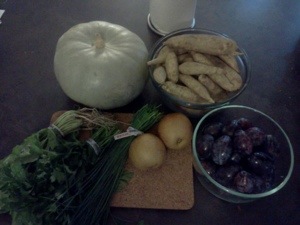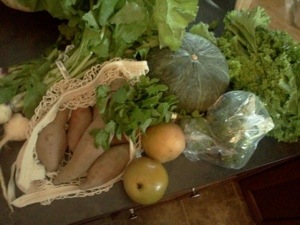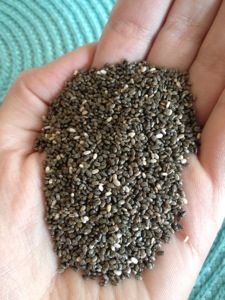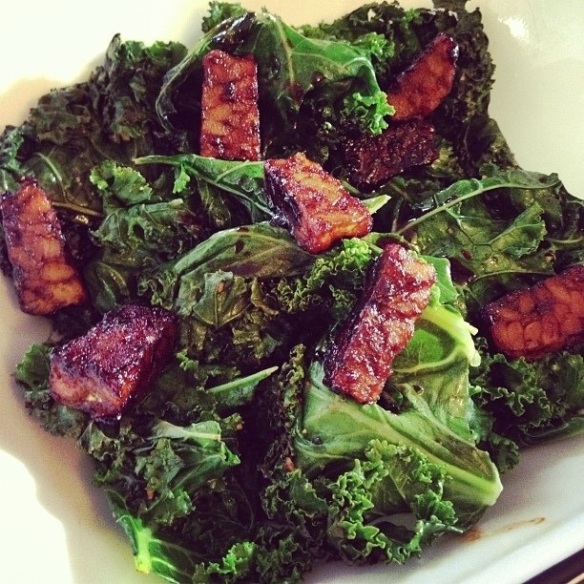I love CSAs (Community Supported Agriculture). They’re honestly completely totally absolutely awesome. As long as you have two or more really good eaters and lots of creativity and/or freezer space. Let me explain.
The CSA available through the farm market closest to us is a little unusual. This could be because the market itself is a little unusual. Unlike other markets I have been to, ours is in part of a large building and has produce set up in much the same way as a supermarket does. There is a small area with bulk bins of various dry beans and grains, a refrigerated case with cheese, eggs, and tofu. A seafood vendor, salsa vendor, a small cookie shop. Another case of milk, ice cream, and various meaty items. Peanuts. Holistic pet food. Other than the few vendor stalls, the cookie shop, and the little cafe, the only other choice you have for interaction is with the cashiers.
I miss going to each “booth” to talk to the farmers, but I also get why they’d just drop off their harvest to be sold here — it lets them go to other markets or spend that valuable time with families or working.
Anyways. I feel like I rambled and got off track there. So, this market is a non-profit organization, open Thursday through Sunday, selling “local” products. I’m not going to get into defining what “local” means in this case, because I have no idea. I may or may not have had an extremely polite “exchange” on Facebook with their seafood vendor (pre-veg days) about using the slogan “Always Fresh, Always Local” while selling salmon from Alaska. Sorry, guys — this is the East Coast.
There are several types of CSAs out there — subscriptions varying in price based on season, number of people you’re feeding, if you’re wanting organic produce, delivered to your doorstep, etc. Some CSAs package your share so it’s all ready for you to pick up. Ours works a little differently.
We pay our subscription fee based on the season (it’s $190-$250, depending) and go to the market once a week for twelve weeks to pick up the items in our CSA share. It’s a bring-your-own-bag affair, and we choose our own items from the bins. There’s generally a placard there saying “Take 6 apples”, or “Choose 2 eggplant” etc. Smaller items like berries or mushrooms are packaged by weight and you simply pick a container. So it’s really fun in that way. You can choose smaller or larger melons/squash/whatever to suit your needs. If you’re an idiot like me, you pick some of the biggest ones and never manage to keep up.
Some weeks were pretty manageable.
Others… not so much.
At the time, I was still eating omnivorously, though trying to stay on top of the CSA share by myself essentially force-converted me to vegetarianism. Not necessarily a bad thing at all. Except I had never really learned to cook with such a variety of produce. It was certainly an education. I was giving away at least half of my share every week and still had roasted squash stuffed in every cranny of my freezer. My produce bins were overflowing with apples.
I had to come up with a solution. One was to start canning. The other was this delicious soup. Even with those stopgap measures, I still managed to fail miserably at keeping up. Learn from my mistakes, but definitely try the soup (I apologize for the lack of photo — this soup isn’t very photogenic, but I’ll try again sometime).
Squash-Apple Soup
Melt margarine in large pot. Add olive oil, onions, and curry. Cook uncovered on low heat 15-20 minutes until onions are tender. Stir occasionally, scraping bottom of pot.
Add squash, apples, salt, pepper, and stock. Bring to boil. Cover. Cook on low 20 minutes, until apples begin to break down. Purée by allowing soup to cool and transferring to a blender or by using an immersion blender.
With soup back in pot, add apple juice to desired consistency. It should be slightly sweet and quite thick. Adjust salt and pepper. Serve hot.
To roast squash: cut in half, scoop out seeds. Place cut-side-down in 9″x13″ dish in 1/2″ of water. Bake at 350F for 40min. Flesh should scoop away easily from the skin.






